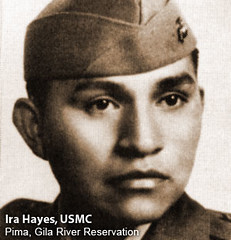North Carolina’s American Indians in World War II
by Dr. David La Vere/Our State Books
Reprinted with permission from the Tar Heel Junior Historian. Fall 2005. Tar Heel Junior Historian Association, NC Museum of History
Tar Heel Junior Historian Association, NC Museum of History
As its Pacific Fleet settled onto the bottom of Pearl Harbor, Hawaii, on December 7, 1941, and the United States prepared to enter World War II, one of the many unknowns facing the country was whether its American Indian citizens would support the war effort. There was good reason to believe that they would not. After all, North Carolina Indians, as did the majority of Indians across the United States, lived in a separate, but certainly not equal, world. Most were denied the right to vote and were segregated from white society, but they still were expected to pay taxes and be drafted to fight. German leader Adolf Hitler imagined that Indians might even rise up against the United States if it went to war against his country and its allies. But in the long run, North Carolina need not have had concerns about the loyalty of its American Indian citizens.
On the Qualla Boundary reservation in the Mountains of North Carolina, every eligible young man in the Eastern Band of Cherokee Indians registered for the draft. Eventually, 321 North Carolina Cherokee served in the military, with 123 enlisting and 198 getting drafted. Unlike African Americans, who served in segregated units, Indians served in integrated units throughout all branches of the military. While Cherokee got along well enough with their comrades, white stereotypes about Indians often worked against them. Commanders imagined that Indians possessed some ingrained warrior ability that enabled them to shoot straighter, walk quieter, and fight braver than other soldiers. This perception meant that Indians often got the most dangerous combat assignments. By the war’s end, eleven North Carolina Cherokee had died in action—five in Europe and six in the Pacific—while a twelfth died stateside. Seven more were wounded in action. Besides a number of Purple Hearts, North Carolina Cherokee earned two Distinguished Flying Crosses and two Silver Stars.
On the home front, the Cherokee tribe was equally active. Eastern Band officials offered to buy $150,000 worth of war bonds, but the federal Bureau of Indian Affairs refused the offer over a bureau-cratic tangle. The tribal council donated $500 to the reservation’s chapter of the American Red Cross. Individual Cherokee, as Americans everywhere, did their part for the war effort by purchasing bonds, collecting scrap metal, and growing Victory gardens of vegetables that the government promoted to guard against food shortages.
In eastern North Carolina, the Lumbee and other smaller Indian tribes supported the war effort with just as much fervor. Back then, the Lumbee tribe was not officially recognized.. They served in every branch of the service, in every theater of operations. In 1942 Thomas Oxendine, a Lumbee from Pembroke, became the first American Indian to graduate from the U.S. Naval Academy and the first to be commissioned as a navy pilot. He served on the USS Mobile as an observation pilot, rescued a downed flier, and was awarded the Distinguished Flying Cross. Eastern North Carolina Indians fought in countless battles, were some of the first Americans to cross the Rhine River in Germany, and helped liberate the Nazi concentration camps. At least twenty-five Lumbee from Robeson County died in the line of duty.
North Carolina’s American Indian women also volunteered. Many served as nurses, and at least one Lumbee woman served as a WASP—Women Airforce Service Pilots—and performed the dangerous duty of towing air gunnery targets for men in training. And Indian women’s work on the home front was incalculable. We can truly say that American Indians helped to win World War II.
At the time of the publication of this article, Dr. David La Vere was a professor in the Department of History at the University of North Carolina at Wilmington. He contributed to North Carolina's Shining Hour: Images and Voices from World War II, published by Our State Books.
References and Additional Resources:
"Pearl Harbor Oahu: Pearl Harbor History." Pearl Harbor Tours. https://www.pearlharboroahu.org/pearlharborhistory.htm
"Thomas Oxendine" , The Robesonian, http://robesonian.com/archive/75402/view-full_story-7744390-article-thomas_oxendine
Image Credots:
Lyons, Rocklin. June 17, 2010. Corporal Ira Hayes, an American Indian from AZ, served in World War II. Located at https://www.flickr.com/photos/judgerock/4709395312/. Accessed February 28, 2012.
1 January 2005 | La Vere, David